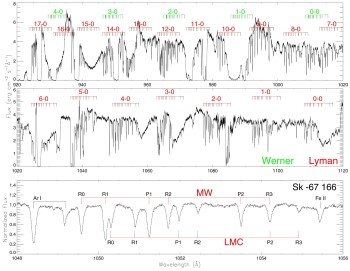 |
TitleFar Ultraviolet Spectroscopic Explorer (FUSE) Spectrum of a Star in the Large Magellanic Cloud
DescriptionThe LMC star is Sanduleak -67 166. The top two panels cover the spectral region from 920 - 1120 Å. To obtain this spectrum a special telescope, FUSE, had to be built with very few reflections and with a much more sophisticated detector than was used for Copernicus. This spectrum took 60 hours to record, three times longer than it took the Copernicus satellite to observe 50 Å in zeta Ophiuchi, a star that is 10,000 time brighter than this one. For this example, FUSE is effectively 7,500 times more efficient than Copernicus. The spectrum is completely dominated by the lines of molecular hydrogen from interstellar space, some in our Galaxy and some in the Large Magellanic Cloud. The spectrum of molecular hydrogen, which contains two hydrogen nuclei (protons) and two electrons, is obviously much more complex than the spectrum of atomic hydrogen. The vibration of the two protons leads to the bands denoted 1-0, 2-0, 4-0, etc., at the top of the two panels. Within each band are very narrow components more closely spaced than the bands, which are due to the rotational motion of the dumbell-shaped molecules (two hydrogen nuclei). The broad, deep features in the spectrum are due to mass-loss from the star itself. There are also some narrow atomic lines mixed in to the spectrum. The bottom (third) panel is an exploded view of an 8 Ångstrom region centered at 1052 Å, representing the 4-0 vibration band seen center left in the second panel. The rotational components from the Milky Way and from the LMC are clearly marked on the third panel, as are the Milky Way and LMC components from neutral argon (Ar I) a the left end of panel three. The vibration and rotation features are quantized, a reflection of the quantum-mechanical natures of the motions on atomic scales. For more information about this spectrum, see Tumlinson, J., Shull, J. M., Rachford, B. L., et al. 2002, ApJ, 566, 857.
FacilityFar Ultraviolet Spectroscopic Explorer (FUSE)
Subject
Spectral TypeUltraviolet
CreditsSpectrum courtesy J. Tumlinson. Reproduced by permission of the AAS.
TypeObservation
Associated LessonUltraviolet Science
|